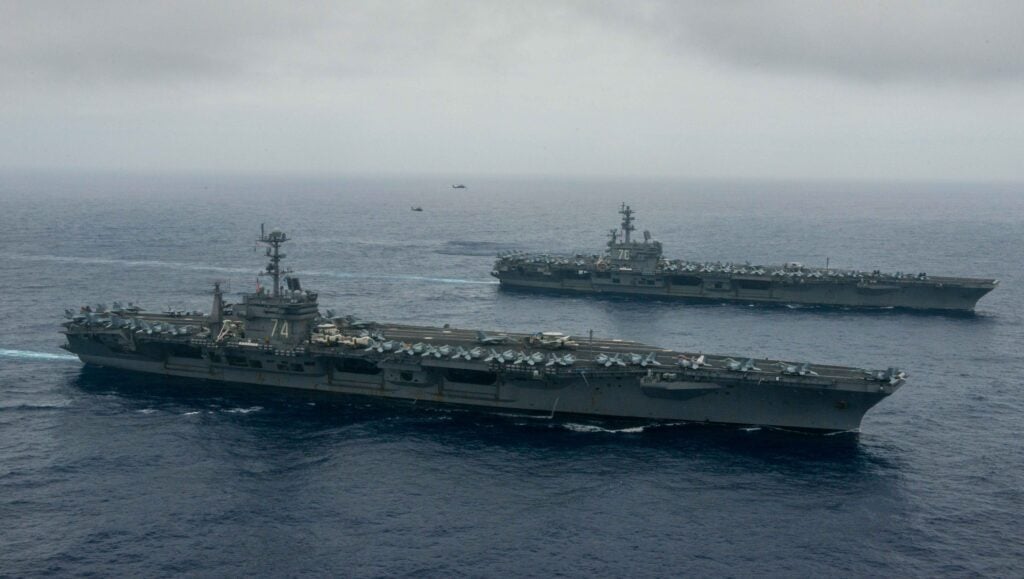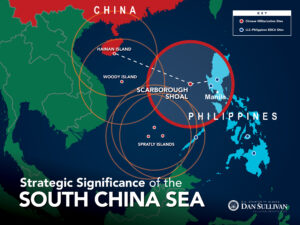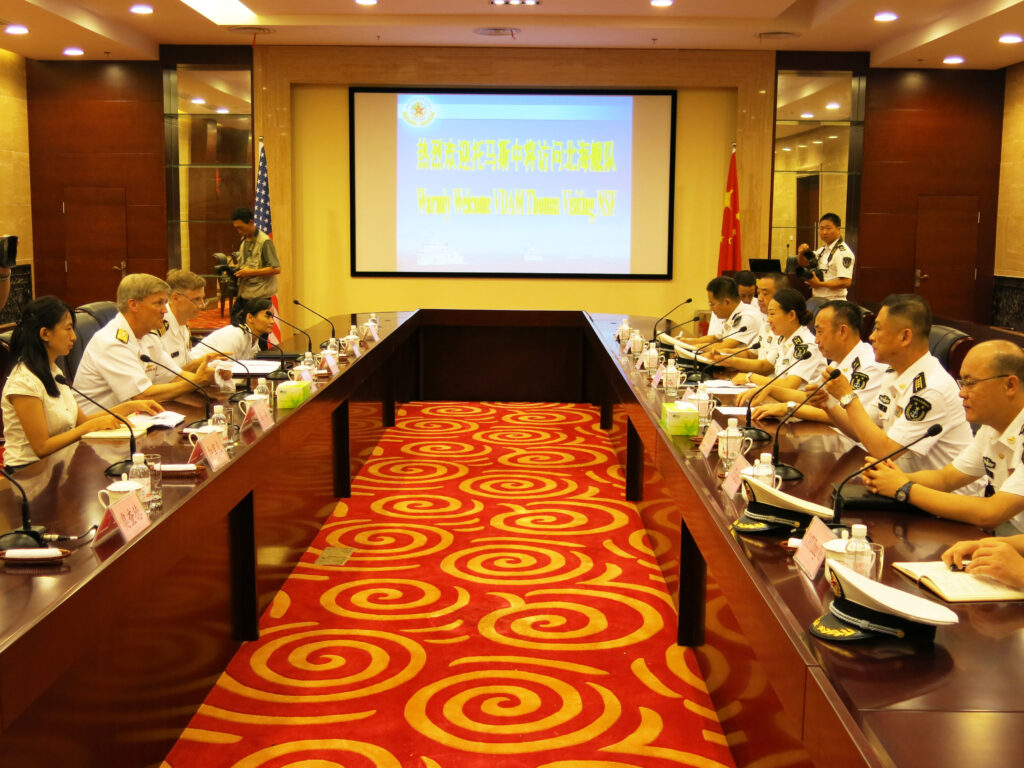UN Ruling Won’t End South China Sea Dispute: Navy Studies Next Clash
Posted on

The Nimitz-class aircraft carriers STENNIS (foreground) and REAGAN (background) operate together in the Pacific.
A UN tribunal ruling could trigger the next round of brinksmanship in the South China Sea as early as next week. But don’t expect the ruling to end the dispute, especially since the Chinese have already vowed to ignore an adverse ruling.
“It’s…not likely to be resolved this year or by one international ruling, no matter how brilliant the arbitrators are,” said Patrick Cronin of the Center for a New American Security. “So it’s going to be a long term (issue) for the next administration.”

Patrick Cronin
The US has taken the rare step of deploying two supercarriers side-by-side in the West Pacific, a dramatic exercise in deterrence. But “if after the arbitration ruling, which may come as soon as next week now, China doesn’t like the result, what if they just ignore the carriers….and say ‘we’re moving our dredgers into the Scarborough Shoal (and) we’re actually going to build our own artificial island here,'” Cronin asked at the CNAS annual conference this afternoon. “What are you going to do about it?”
China is seeking to neutralize US power in two ways. The high-end counter is to build an Anti-Access/Area Denial (A2/AD) network. This layered defense of cyber/electronic weapons, long-range sensors, anti-ship missiles, anti-aircraft missiles, strike planes, submarines, and mines aims to keep US forces from meddling in what China considers its backyard. This is the high-end deterrent.
But China’s much more likely to use its low-end force, the maritime equivalent of Vladimir Putin’s deniable Little Green Men: Chinese Coast Guard vessels, dredging ships (as in Cronin’s hypothetical scenario), and fishing boats that can push into disputed territory without raising the risk of a military clash.

Adm. John Richardson
This is forcing the US Navy to think hard. In fact, “we’ve got a lot of studies going on right now, (and) by the July-August timeframe, we’re going to have a lot of exciting ideas,” Chief of Naval Operations Adm. John Richardson told the CNAS conference.
Press attention has fixated on whether the Navy will say increasing threats require it to grow beyond its current goal of 308 ships (protip: It will). But what’s at stake is much more than that, Adm. Richardson made clear to me after his public remarks.
“It’s not just the number, but what shape does that fleet take and what sort of capabilities do we need to be bringing to bear and how are we going to go after those,” the CNO told me. “We’ve got a lot of intellectual energy going on (and) in the late summer-fall, we should be hearing some results.”

The STENNIS and REAGAN battlegroups operate together in the Philippine Sea.
Cracking “Anti-Access”
Those studies, Richardson said, include “my summer project” on how to defeat Chinese-style Anti-Access/Area Denial defenses. Just because someone says they can deny access to an area, he told the conference, doesn’t mean they can.
“A2/AD is an aspiration,” Richardson said. “The actual execution of that is much more difficult.”
China’s artificial islands in the South China Sea — technically considered “land reclamation” and not recognized by international law as sovereign territory — do complicate the A2/AD calculus, Richardson said, especially when China builds bases on them for long-range sensors, missiles, and strike aircraft. But it’s easy to oversimplify and scare yourself.
“What you see often is you see a display (showing) ‘here’s a launcher, here’s a circle with a radius of 700 miles, and it’s solid-color black inside that like, hey, can’t go,'” Adm. Richardson said. “That’s just not the reality of the situation.”

Graphic courtesy Sen. Dan Sullivan
“In the cleanest form, (on) the uninterrupted frictionless plain,” Richardson said to laughter, “you have the ability to sense a target much more capably and quickly around the world, you’ve got the ability then to transmit that information back to a weapons system that can reach out at a fairly long range…. out to 100s of miles.”
But the US Navy won’t just sit there gawping with a bull’s-eye on its back.
“You’ve got this highly maneuverable force that’s got a suit of capabilities to respond,” Richardson said. “Our response would be to inject a lot of friction in that system… every step of the way to make that much more difficult.”
While the CNO didn’t give examples today, recent Navy thinking has emphasized a whole range of counters:
- cyber attacks to disrupt enemy command networks or inject false information;
- electronic attacks to jam or deceive enemy radars and radios;
- offensive strikes to destroy enemy sensors, communications, or launchers;
- missile defense to down incoming enemy missiles with interceptor rockets, hyper-velocity projectiles, or lasers;
- electronic deception to make decoys look like ships and real ships look like noise.
All these tactics take not only advanced technology but extensive practice. That’s a problem for a fleet that’s constantly fighting maintenance backlog and shortages of ships to cover routine deployments. In particular, there’s rarely enough slack in the system to put two carriers in the same place at the same time — but that’s precisely the kind of complex operation you’d need to practice for a major war.
“We don’t get to do two-carrier operations very often; our readiness model has been leaned out,” Richardson said. “It’s a terrific opportunity for us to do some (training for) high-end warfighting.”
The Navy and indeed all the services are particularly focused on the concept of “cross-domain” warfare. Instead of a submarine simply firing torpedoes at enemy ships, for example, it can now launch cruise missiles deep inland, and soon might be able to launch flying drones to conduct radar jamming or even cyber attacks. “We just don’t have the luxury of concentrating on undersea, on the surface, and in the air (as separate arenas),” Richardson said. “You’ve got to build everything from the sea floor literally up into space (and integrate) the information domain as well.”
The study groups are powering through all these complexities, the CNO said. “The teams are moving through that extremely quickly, they are really being creative (and) coming up with new ways to operate.”

Navy officers from the US (left) and China (right) meet in Qingdao.
Reaching Out To China
Meanwhile, in parallel to figuring out new ways to fight and to deter, the Navy is reaching out to China. “Cooperation would be great, competition is” — a long pause — “fine,” the CNO said. “Conflict is the thing that we really want to avoid.”
Richardson himself is heading to China next month to meet with his counterpart. He’ll press for expanding a code of conduct signed by the two navies — the Code for Unplanned Encounters at Sea, or CUES — to the often-aggressive Chinese Coast Guard as well. He’ll also remind his hosts that “the invitation is still there for the Chinese to participate in RIMPAC,” the huge annual international exercises in Hawaii.
When Richardson visited the Stennis as it sailed through the South China Sea itself, “you could see from the Stennis that there were ships from the People’s Liberation Army Navy in visible range,” Richardson said. The interactions between the US strike group and the Chinese, he said, were “very professional” and “routine.”
“There’s some hope after the UNCLOS ruling that we’re going to be at least managing the tensions,” said Cronin. China could certainly escalate if they desired, but lately, he said, “the Chinese have been looking to ratchet down the tensions even while they’ve tried to move their influence forward.” In other words, don’t expect fighting, but don’t expect acquiescence to the UN ruling either.
“Patrick is right: The ruling solves nothing, nor was it meant to,” Gregory Poling of the Center for Strategic & International Security told me in an email. “It will add additional pressure on Beijing, and it will help define the boundaries of any future negotiations — likely years away — but it cannot resolve the disputes.”
Far from resolving disputes, agreed fellow CSIS scholar Bonnie Glaser, “the ruling is likely to increase tensions at least in the near term. In a sense it already has, as China has rejected the ruling, and many countries of the world have taken sides, with the US seeking to rally nations in support of international law and a rules based order — i.e. against China’s rejection.”
“In the short term, we’ll probably see China engage in some new escalation to punish Manila and signal that it will not be bound by the ruling,” Poling said. For example, said Glaser, “China may establish baselines (for its territorial claims) in the Spratlys, a precursor to announcing an ADIZ (Air Defense Identification Zone).”
Besides the legal and maritime maneuverings, Poling said, “we will also see the start of the next phase of the battle over competing narratives, this time focused on how many countries Manila and friends can get to voice public support for the ruling as legally binding and demand China complies. (The question) will be whether or not they can maintain that pressure from a broad swath of countries over the long term” in the face of Chinese diplomatic and economic pressure.
“The South China Sea territorial disputes are likely to persist for a long time,” said Glaser. “The question is whether they can be managed, not resolved.”
Subscribe to our newsletter
Promotions, new products and sales. Directly to your inbox.
